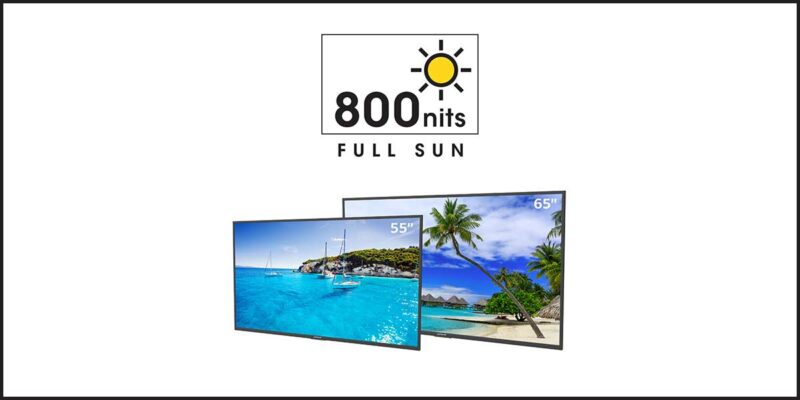What to Consider When Choosing an Outdoor Digital Signage Display
Folks in commercial AV integration certainly know: you can’t just take any old display, put it outside and call it a day.
So, how exactly do you select a display for commercial outdoor use? Here’s some features you should be looking for in an outdoor display:
Polarization
One of the features that has been recently incorporated into outdoor displays is polarization, a critically important consideration when putting a display in direct sunlight. All too often, a customer drives up to the menu at a quick service restaurant while wearing polarized lenses and they are either unable to read the content or the menu board is completely blacked out to them.
One way to combat this issue is with a secondary polarization film, which ensures content is always readable, even in direct sunlight. As an alternative, retrofit films can usually be added to any display.
Safety Glass
Simply put: this is very important for durability and longevity in outdoor spaces. Your display will face the elements and potential security issues associated with an unattended display. You’ll want to ensure your display is protected from scratches and blunt force. Safety glass will protect your display, your property, and your customers.
Optic Bonding
Accomplishing many things, optic bonding is a process used in the manufacturing of outdoor displays. First, it reduces glare through the UV absorptive gel. The gel is inserted in displays between the protective glass and the screen, eliminating reflection.
Secondly, optically bonded displays are much stronger — a nice byproduct of the process, as it’s very important to have something that’s durable if it’s going to be outside at all times.
Finally, optic bonding reduces the display’s solar load, which keeps it cooler and prevents it from going isotropic and blacking out. While optically bonded commercial displays may cost an integrator about 20 percent more up front, the long-term operational costs will most definitely be reduced. With optic bonding, the need for fans and filters or air-conditioned, protective enclosures is negated. Users will see a decrease in energy consumption and maintenance costs over the life of the display.
Professional vs. Consumer
At first glance, many integrators may be enticed to buy a consumer display at a lower price. However, you have to look at items like warranty — for example, as soon as you put a consumer display outside, the warranty may be null and void. Most commercial screens have a two-year warranty that covers 24/7 outdoor use.
This is important to consider as an integrator so that you may give peace of mind to your customer and eliminate service calls and other maintenance costs.
Ambient Light Sensor
Finally, look for displays that incorporate a built-in ambient light sensor. If it is cloudy or the sun is setting, the panel will adjust lighting based on the ambient light outside, in a fashion similar to how your smart phone’s screen will adjust to lighting conditions. Again this is an important feature in outdoor settings to keep everything legible and readable.
A new professional outdoor display will update and modernize the look of your establishment and allow you to keep customers entertained and happy. Have you thought about adding outdoor digital displays to your business?






